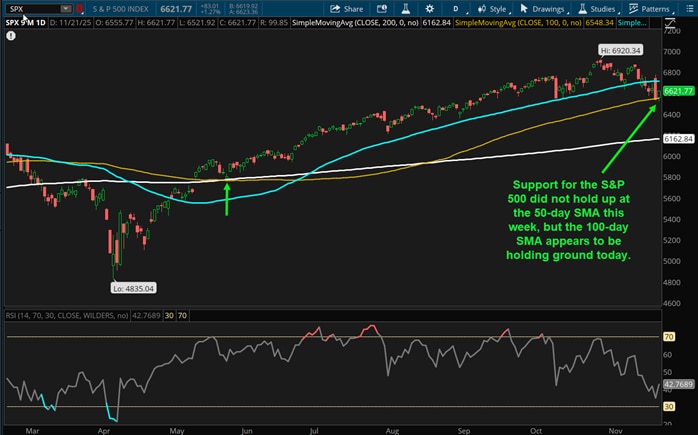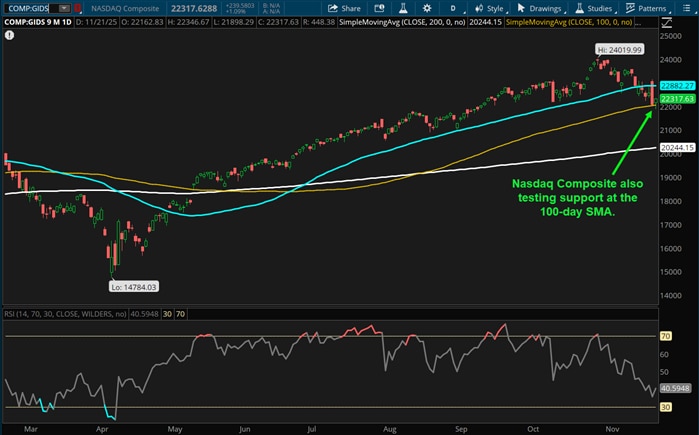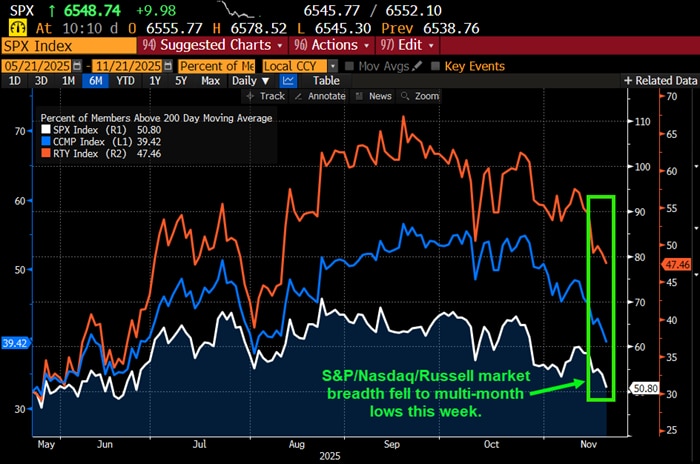Weekly Trader's Outlook
Stock Volatility Remains Elevated as AI Angst Persists

The Week That Was
Note: Due to Thanksgiving and the shortened trading week, we will not publish a Weekly Trader's Outlook on Friday, November 28th.
If you read last week's blog you might recall that my forecast for this week was "moderately bullish," citing the encouraging technical setup heading into this week since the SPX and Nasdaq Composite appeared to be finding support (once again) at their respective 50-day Simple Moving Averages (SMA). However, on Monday the apparent support gave way to continued selling pressure and all the majors closed below their respective 50-day SMA for the first time since April. I did note in last week's "Technical Take" section that I was cautiously bullish on the SPX, since a higher frequency of tests at a support level can be a bit of an orange technical flag. Regardless, my forecast turned out to be wrong and the SPX is on track to be down roughly 1.3% on the week. The bearish price action appeared to be primarily due to an overhang of investor concerns around AI overinvestment, heavy debt issuance, and high valuations. On Wednesday Nvidia delivered a solid "beat and raise" quarter, but the stock's initial gap-up on Thursday gave way to additional selling pressure which put all the major indices in the red by the close.
Elsewhere, the flow of economic data started again this week following last week's cessation of the government shutdown. The September Nonfarm Payrolls report was released yesterday, but the data was mixed and relatively stale, so the current state of the labor market remains a little murky. However, New York Fed President John Williams delivered some dovish commentary earlier today which helped initiate an intraday reversal in stocks and improve market expectation around a potential December rate cut (more on this in the "Economic Data, Rates & the Fed" section below).
Outlook for Next Week
At the time of this writing (2:25 p.m. ET), stocks are trading near the highs of the day (DJI + 793, SPX + 119, COMPX + 449). Certainly, William's dovish comments helped ignite today's intraday turnaround, but the technicals are also contributing to the push higher. Stocks were near-term oversold at the lows today and both the S&P 500 and Nasdaq Composite appear to have found support at their respective 100-day SMA's (more on this in the "Technical Take" section below). The Cboe Volatility Index (VIX) has correspondingly cooled off some, currently 22.64 after getting as high as 27.84 earlier today, but a move below 20 would be more ideal for the bulls in my view. Next week will be holiday-shortened, but there will be a barrage of economic data hitting the tape next Wednesday, so the potential for market volatility is there. I'm not sure if the recent pullback in stocks or investor concerns around AI has been fully played out yet, but today's price action is encouraging from a near-term perspective. And I'll remind readers of the bullish seasonality that has historically accompanied the stock market during this time of year. Therefore, my forecast for next week is "moderately bullish." I know that I felt good about the technical set-up last Friday heading into this week, which turned out to be misguided, but this week's deeper pullback in stocks tilts the probability of a near-term bounce in my view. What could challenge my forecast? If there are more AI deal announcements, or a continued push higher in CDS premium from AI players like Oracle, this could weigh on investor sentiment and lead to selling. Another potential bearish catalyst would be a hot personal consumption expenditure (PCE) report next Wednesday.
Other Potential Market-Moving Catalysts
Economic:
- Monday (Nov. 24): no reports
- Tuesday (Nov. 25): Consumer Confidence, Producer Price Index (PPI), FHFA Housing Price Index, Pending Home Sales, SA&P Case-Shiller Home Price Index
- Wednesday (Nov. 26): Advertised International Trade in Goods, Advanced Retail Inventories, Advanced Wholesale Inventories, Chicago PMI, Durable Orders, EIA Crude Oil Inventories, Q3 GDP – Second Estimate, MBA Mortgage Applications Index, New Home Sales, PCE Prices, Personal Income Personal Spending, Continuing Claims, EIA Natural Gas Inventories, Initial Claims
- Thursday (Nov. 27): no reports
- Friday (Nov. 28): no reports
Earnings:
- Monday (Nov. 24): Agilent Technologies Inc. (A), Amentum Holdings Inc. (AMTM), Corporation America Airports SA (CAAP), Keysight Technologies Inc. (KEYS), Semtech Corp. (SMTC), Symbotic Inc. (SYM), Woodward Inc. (WWD), Zoom Communications Inc. (ZM)
- Tuesday (Nov. 25): Alibaba Group Holding Ltd. (BABA), Analog Devices Inc. (ADI), Autodesk Inc. (ADSK), Best Buy Co. (BBY), Burlington Stores Inc. (BURL), Dell Technologies Inc. (DELL), Dick's Sporting Goods Inc. (DKS), NetApp Inc. (NTAP), NIO Inc. (NIO), Workday Inc. (WDAY), Zscaler Inc. (ZS)
- Wednesday (Nov. 26): Banco Macro SA (BMA), CMB Tech NV (CMBT), Deere & Co. (DE), Ehang Holdings Ltd. (EH), Li Auto Inc. (LI)
- Thursday (Nov. 27): no reports
- Friday (Nov. 28): no reports
Economic Data, Rates & the Fed
The economic data pipes opened back up this week with the release of the September Nonfarm Payrolls report. The report was mixed as the headline figure came well above estimates, but August was revised lower and the Unemployment Rate ticked up. The more current Initial Claims data appears to be conveying labor market stability, though several Federal Reserve members seemed concerned around recent labor market weakness. Here's the breakdown from this week's reports:
- Nonfarm Payrolls: September jobs increased 119K, well above the +51K expected. However, August was revised down from +22K to -4K.
- Unemployment Rate: Ticked up to 4.4%, which was above the 4.3% expected, though likely driven by an increase in the labor force participation rate.
- Average Hourly Earnings: +0.2%, slightly below the +0.3% expected.
- Construction Spending: +0.2% vs. 0.0% est.
- Empire State Manufacturing: 18.7 vs. 7.5 est
- Factory Orders: 1.4% vs. 1.0% est.
- NAHB Housing Market Index: 38 vs. 35 est.
- University of Consumer Michigan Sentiment - Final: Rose to 51.0 in November from 50.3, but the reading represents the second lowest on record. The Current Economic Conditions Index plunged 12.8% to an all-time low of 51.1. Year-ahead inflation expectations eased slightly to 4.5% from 4.6%, which represents three consecutive months of declines. Longer-term inflation expectations dropped to 3.4% from 3.9%.
- Initial Jobless Claims: Initial applications for U.S. jobless benefits dropped to 220,000 for the week ending November 15th from 228,000 in the prior week and below the 227,000 economists had expected. Continuing Claims rose to a four-year high of 1.957M from 1.947M in the prior week.
- EIA Crude Oil Inventories: -3.43M barrels
- EIA Natural Gas Inventories: -14 bcf
- The Atlanta Fed's GDPNow "nowcast" for Q3 GDP was revised up to 4.2% on Wednesday, up from 4.1% on November 17th, primarily driven by an increase in the nowcast of the contribution of net exports to Q3 GDP growth from 0.57% to 0.78%.
U.S. Treasury yields rose across the board this week following the more hawkish "Fed speak" referenced above. Compared to last Friday, two-year Treasury yields are down ~10 basis points (3.516% vs. 3.614%), 10-year yields are down ~3 basis points (4.073% vs. 4.148%) and 30-year yields are higher by a little over one basis point (4.725% vs. 4.746%).
Rate cut probabilities from the Federal Reserve climbed back up this week following the prior week's drop, helped by dovish commentary from Fed members Christopher Waller and John Williams. Per Bloomberg, the probability of a 25-basis-point cut at the December Federal Open Market Committee meeting currently sits at 65% from 43% last Friday. The total number of 25-basis-point cuts between now and the end of 2026 moved up to 3.66 from 3.19 last Friday.
Technical Take
S&P 500 Index (SPX + 82 to 6,621)
Last week the S&P 500 index (SPX) was in the process of testing support at its 50-day Simple Moving Average (SMA) and it held up by the end of the trading session. However, the SPX dropped through this "support level" on Monday which is an incrementally bearish shift. Last Friday I gave the SPX a "cautiously bullish" near-term outlook, because I was concerned about the higher frequency of support tests at the 50-day SMA over the past month. The floor finally gave in so to speak, but there is some encouraging (for the bulls that is) price action today. The SPX has seen a fairly significant intraday rebound at the time of this writing, and the bid support is occurring at the 100-day SMA (the gold line in the chart below). It's too early to say that near-term support has been defined at this moving average, but the price action is encouraging. Therefore, from a near-term perspective, investors appear to have a line in the sand to trade against and the near-term assessment is moderately bullish.
Near-term technical translation: moderately bullish

Source: ThinkorSwim trading platform
Past performance is no guarantee of future results.
Nasdaq Composite Index (COMP + 239 to 22,317)
Sentiment around the AI trade and the tech-heavy Nasdaq Composite (COMP) have been under pressure this month, driven by investor concerns around overinvestment, heavy debt issuance and lofty valuations. AI-darling Nvidia reported a strong "beat and raise" quarter on Wednesday, but yesterday's sharp reversal was bearish price action and signals lingering AI concerns. However, like the S&P 500, the COMP appears to be finding support at its 100-day SMA today, which is a near-term bullish victory, assuming the index ends today's session above this indicator.
Technical translation: near-term bullish

Source: ThinkorSwim trading platform
Past performance is no guarantee of future results.
Cryptocurrency News
Bitcoin's (BTC - $1,900 to $84,623) near 30% drawdown in the month of November isn't unheard of from a historical perspective but is the most important "news" in my view given BTC's leadership status in the crypto space. Some analysts have pointed to the wider-spread "risk off" investor sentiment, driven by concerns around the AI infrastructure buildout, while others cite the historical intermediate-term BTC price peak that occurs roughly 18-20 months after a halving event (the last BTC halving occurred in April of 2024). However, JPM analyst Nikolaos Panigirtzoglou said that retail investors are primarily to blame, having sold roughly $4B of spot bitcoin and ether ETFs so far this month, which already exceeds February's record outflows. At the same time, Panigirtzoglou noted that investors have poured $96B into equity ETFs and said that "it would be a mistake to extrapolate the selling of crypto ETFs as a signal that retail investors are turning bearish on risk assets more broadly including equities." Regardless, although the price of BTC has dropped below its 200-day SMA, an indicator where the coin found support back in April, the Relative Strength Index (RSI) is registering an oversold reading of 25 today, so perhaps the price is nearing a technical snap-back bounce.
Market Breadth
The Bloomberg chart below shows the current percentage of members within the S&P 500 (SPX), Nasdaq Composite (CCMP), and Russell 2000 (RTY) that are trading above their respective 200-day Simple Moving Averages (SMA). In short, stocks are on track for weekly losses, and market breadth deteriorated as a result. Market breadth for the SPX, CCMP, and RTY are all at multi-month lows today. On a week-over-week basis, the SPX (white line) breadth dropped to 50.80% from 54.86%, the CCMP (blue line) fell to 39.42% from 45.92%, and the RTY (red line) contracted to 47.46% from 54.86%.

Source: Bloomberg L.P.
Market breadth attempts to capture individual stock participation within an overall index, which can help convey underlying strength or weakness of a move or trend. Typically, broader participation suggests healthy investor sentiment and supportive technicals. There are many data points to help convey market breadth, such as advancing vs. declining issues, percentage of stocks within an index that are above or below a longer-term moving average, or new highs vs. new lows.
This Week's Notable 52-week Highs (5 today): Albemarle Corp. (ALB - $1.75 to $114.67), Alphabet Inc. (GOOGL + $11.71 to $301.11), Dycom Industries Inc. (DY + $8.73 to $332.10), Johnson & Johnson (JNJ + $1.07 to $204.14), Lumentum Holdings Inc. (LITE + $15.96 to $249.20), TJX Companies (TJX + $2.08 to $150.15)
This Week's Notable 52-week Lows (145 today): Adobe Systems Inc. (ADBE + $1.74 to $314.14), Charter Communications Inc. (CHTR + $4.64 to $199.35), Clorox Company (CLX + $1.48 to $101.55), Duolingo Inc. (DUOL + $2.81 to $170.82), F5 Inc. (FFIV + $1.89 to $227.72), Strategy Inc. (MSTR + $1.00 to $178.13)
Get expert insights on market drivers and their potential impact to your portfolio. Join us for this Schwab Coaching special event: the 2026 Market Outlook on December 11 at 7:00 p.m. ET. Just tune in to our media affiliate Schwab NetworkTM* to see what our experts think might affect the markets next year.